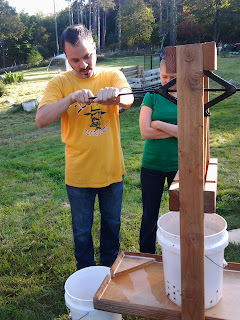This morning I harvested chickens. The birds were three-months plump and ready. Farmer friends at a
local non-profit farm invited us to help out, and since we plan on getting spring chickens, this was a perfect chance to test my skills and stomach.
The steps to harvesting a chicken are quite simple: catch the chicken, kill the chicken, de-feather the chicken, eviscerate the chicken, rinse and store the chicken. The little tips I learned from the farmers were worth it, e.g., catch the chickens at night when they are more docile, don't feed them grain the day before a harvest so they are cleared out, hold both legs and rest the breast on your leg to calm them, don't cut the head off because you want the brain to keep telling the heart to pump the blood so it drains, and more...
The facilities in this processing room are bigger than we'd ever get: they had a six-cone holder for the jugular cuts, a rotating hot water bath for loosening the feathers, and a large spinner to extract the feathers in 10 seconds. I suppose what we'll be doing next year is plucking those feathers out by hand... but there's still plenty of time to conceive of and build a contraption.
The evisceration comes easier with each bird. There are parts you save (e.g., the liver, heart, neck, gizzard and feet) and parts you toss (e.g., the gall bladder, the lungs, the windpipe). And the clean chicken, standing upright on a small post to drain and dry in the cooler, looks ready to roast (but another tip they told me was to leave it one night in the fridge to tenderize the muscles a bit).
These clinical pointers aside, we can't ignore the fundamental issue of killing a living being for our own consumption. The range of feelings behind this are widespread and often politically- and spiritually-heated. I personally believe that my ability to consume an animal as a human should be tied to my willingness to harvest that animal. And that the harvesting of that animal should be conducted with respect and as humanely as possible. And furthermore, that the full life of that animal should also be respected, which in the case of chickens means protecting them with shelter, providing them with nutritious food, and allowing them to forage in the fields as they would naturally. This is what distinguishes a family or small farm's operation from a modern commercial operation.
Harvesting chickens? No problem. We'll see when it comes to pigs and sheep.



































